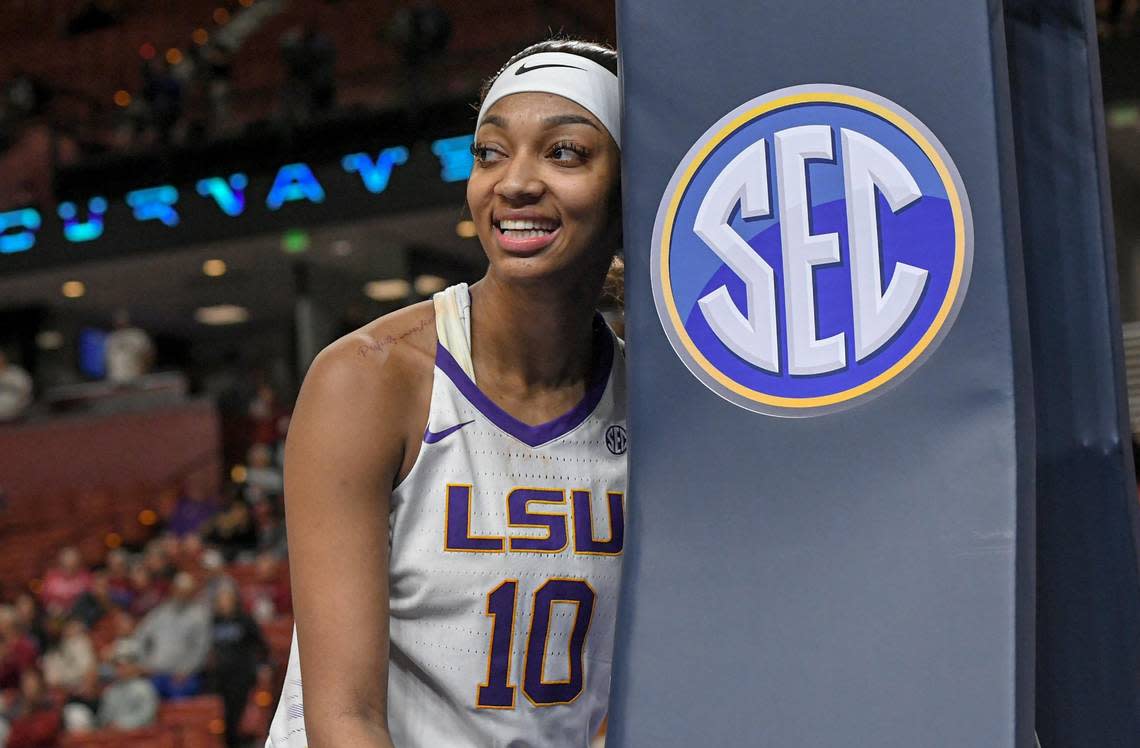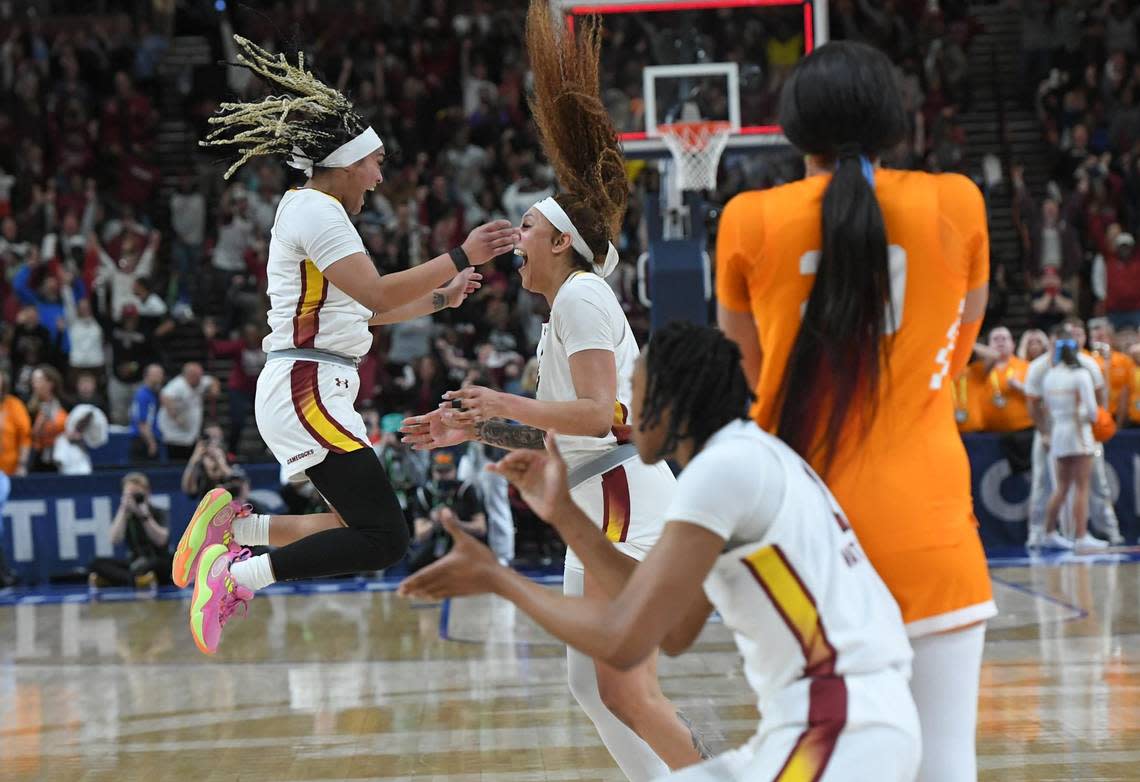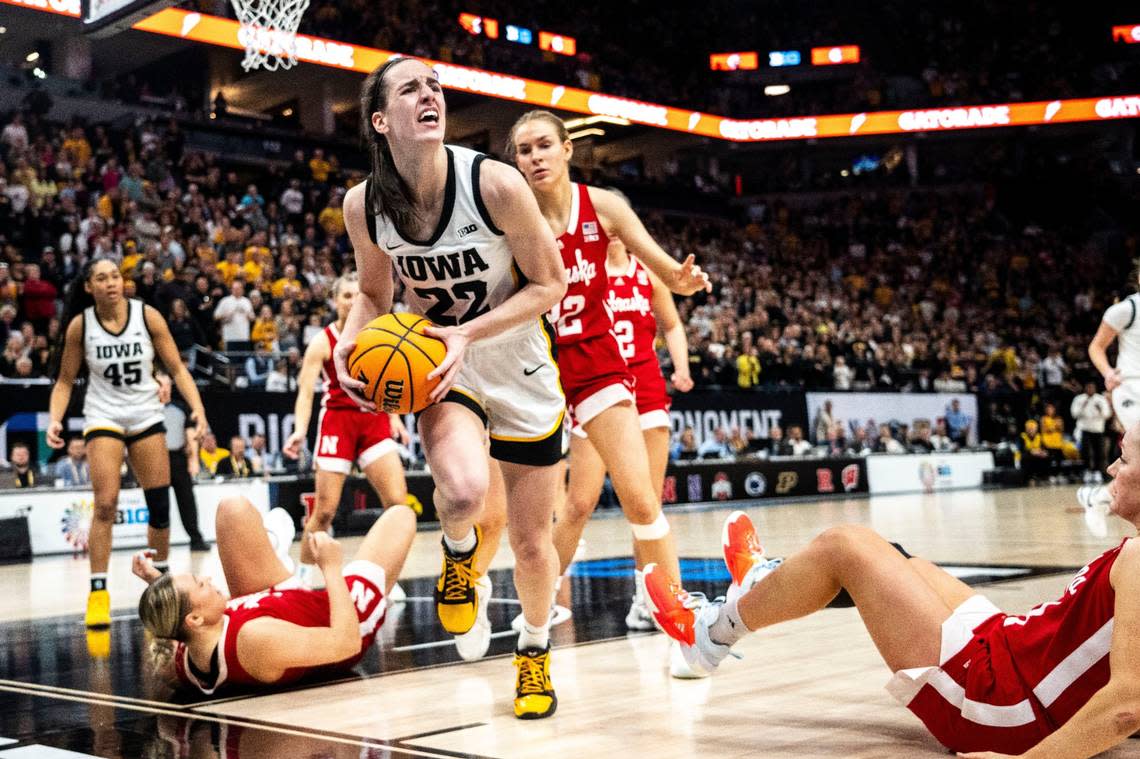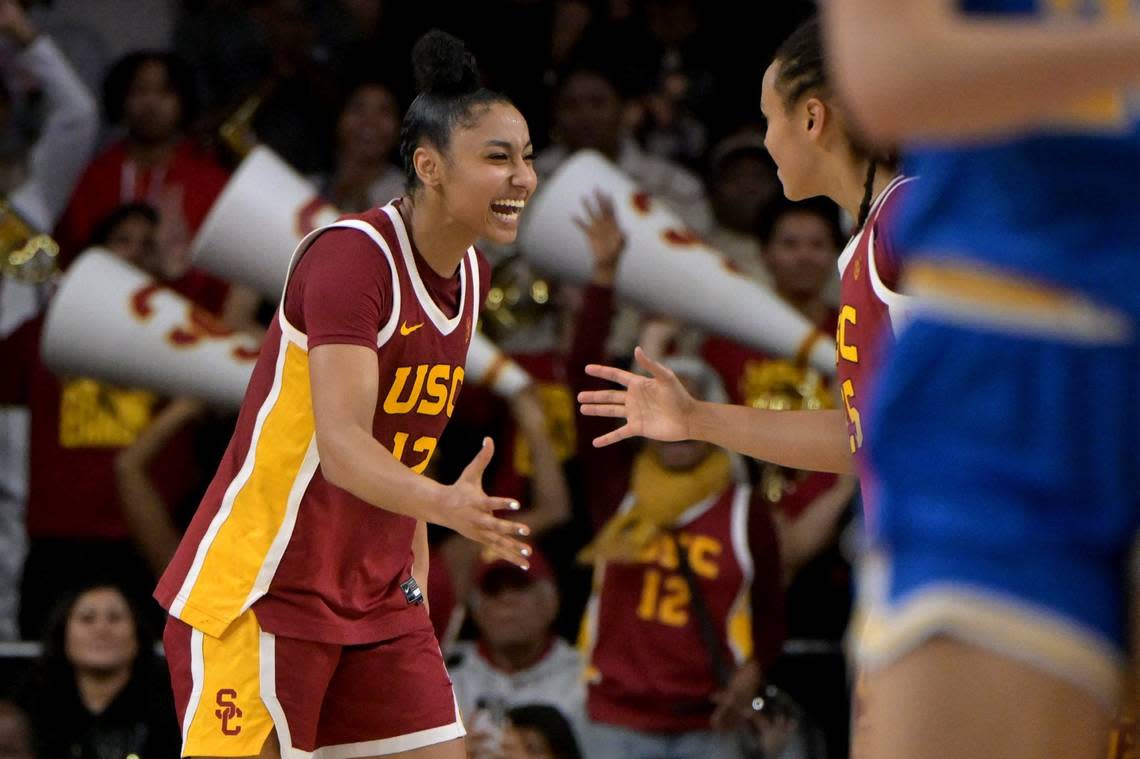March Madness: Twelve questions (and answers) ahead of the 2024 women’s NCAA Tournament
NCAA Tournament season is upon us.
The 2024 women’s NCAA Tournament, beginning with the First Four on March 20 and 21, will once again feature high-profile stars and powerful programs searching for greatness in a sport rapidly growing in popularity.
Whether you’re tracking Caitlin Clark’s point total in her final bow in college basketball, predicting upsets on the sport’s biggest stage or are convinced South Carolina will remain undefeated en route to its third national championship, there are countless narratives to watch during March Madness.
From the unique setup of the opening rounds to misinformation regarding big-time paydays, you might be wondering about more than a few things heading into another NCAA Tournament.
Here are 12 questions and answers to get you ready for this year’s Big Dance:
When and where is the Final Four this year?
This season’s Final Four will take place at the Rocket Mortgage FieldHouse in Cleveland. The venue is typically home to the NBA’s Cleveland Cavaliers.
Final Four games will tip off on Friday, April 5, with the championship game taking place on Sunday, April 7. It marks the first time Cleveland will host the women’s Final Four since 2007, when Pat Summitt and Candace Parker guided Tennessee to the school’s seventh national title.
Where are the other NCAA Tournament games being played?
When all is said and done, more than 15 additional sites will join Cleveland in hosting NCAA Tournament games this year.
As the NCAA reveals the 68 teams selected for the 2024 NCAA Tournament on Sunday, the 16 sites hosting first- and second-round games will also be announced. The top-16 individual seeds earn the right to host games in the first round (March 23-24) and second round (March 24-25). Expect the familiar locations of Austin, Texas; Columbia, South Carolina; Storrs, Connecticut; and Stanford, California, among others, to receive hosting privileges again this year.

Who are the defending champ and some favorites to win this year?
Last year, LSU won the NCAA Tournament as a No. 3 seed for the first national championship in program history. It marked head coach Kim Mulkey’s fourth title as a coach after three with Baylor (2005, 2012, 2019). Mulkey also won two national championships as a point guard with Louisiana Tech in 1981 and 1982, though the NCAA only officially recognizes the Techsters’ 1982 win — the first official year of the women’s NCAA Tournament.
LSU stands a chance at repeating, with megastar and reigning Final Four Most Outstanding Player Angel Reese leading a reloaded roster, but, just like last season, the Tigers aren’t the favorite to take it all.
Two-time national champion South Carolina is the odds-on favorite to hoist the national championship trophy thanks to an undefeated regular season, an SEC Tournament championship by defeating LSU in the finals, and staggering depth.
Other top contenders to win it all include the Big Ten’s Iowa and Ohio State and Stanford, the Pac-12 champion for the fourth straight season and fellow conference members Southern Cal and UCLA.

What TV channels will the games be on?
ESPN owns the broadcast rights to every women’s NCAA Tournament game. They will be available to watch across ESPN platforms, including ESPN, ESPN2, ESPNU, ESPN News and ABC, with opportunities to stream on ESPN+.
How much do schools earn by winning NCAA Tournament games?
The inequity between NCAA men’s and women’s basketball took center stage in the public conversation when, during the 2021 NCAA Tournament, then-Oregon Duck Sedona Prince revealed the glaring differences between facilities provided to participating teams via a viral TikTok.
While the NCAA rewards men’s tournament teams by distributing money to conferences instead of individual schools by way of “revenue distribution units,” there is no equivalent system for women’s basketball. Perhaps one of the most-maligned differences between the men’s and women’s NCAA tournaments? The TV deals. Per The Athletic, the Division I men’s basketball tournament has its own TV deal with Paramount Global and Warner Bros. Discovery — while the Division I women’s tournament’s broadcast rights belong to ESPN and exist in a bundle containing 28 other sports championships.
Ahead of its current TV contract (valued at $34 million annually) expiring at the end of the 2023-24 season, the NCAA announced in early January that it signed a new contract with ESPN valued at $115 million annually, expiring in 2032. NCAA president Charlie Baker told The Athletic that the NCAA will look into a revenue distribution unit system to reward women’s basketball teams.
How much money are players paid?
Individual players are not paid for their participation in NCAA Tournament games, but they can earn money through the usage of their name, image and likeness. And right now, with women’s college basketball viewership reaching all-time highs — such as the 2023 NCAA national championship game peaking at 12.6 million viewers (per ESPN) and this season’s games averaging 981,000 viewers (per Sportico) — it’s a lucrative time to be a women’s college basketball player. NIL opportunities provide the potential for all players to make money and gives future WNBA players a head start on endorsement deals — which don’t end after graduation.
UConn redshirt junior guard and two-time Big East Player of the Year Paige Bueckers has been one of the most marketable players in the game since the NCAA ruled student-athletes could make money through NIL. She was the first student-athlete to partner with Gatorade in 2021, and since then has signed deals with Bose, Nerf and Nike, among others.
Who has won the tournament the most times?
No school can claim more national titles than UConn, which earned its 11th (and fourth consecutive) in 2016.
Tennessee is second all-time with eight national championships, followed by Baylor and Stanford (three). South Carolina, Notre Dame, Louisiana Tech and Southern Cal have two apiece. All but Louisiana Tech will be in the 2024 tournament.
How many times have Kentucky teams won the tournament, and what should we expect this year?
Not only has UK never won a Division I national championship, no team from the state of Kentucky has ever hoisted the trophy.
Two schools, Louisville and Western Kentucky, have come the closest. Louisville has a pair of NCAA Tournament runner-up finishes in 2009 and 2013 under current head coach Jeff Walz, and WKU reached the national championship game in 1992 under longtime head coach Paul Sanderford.
Prior to its transition to Division I in 2012, Northern Kentucky won the Division II national championship in 2000 and 2008.
What other Kentucky connections will be in this year’s tournament?
Though the Wildcats will miss the NCAA Tournament for the second straight season, a few ex-Cats will take part in the Big Dance.
Amber Smith — UK’s point guard from 2007-12, director of player development from 2016-18 and assistant coach from 2018-23 — joined Indiana’s coaching staff as an assistant ahead of this season. According to the NCAA’s latest top-16 committee rankings, the Hoosiers are the 14th overall seed. While that might shift after the team’s upset loss to bubble team Michigan in the Big Ten Tournament, Indiana is squarely in the field.
Ex-cats Dre’Una Edwards (2019-22) and Jada Walker (2021-23) helped Baylor to a 24-7 record this season, with the Bears peaking inside the Associated Press top 10 in December. A 12-6 conference record dimmed Baylor’s shine, but the Bears remain a Quad 1 team.
Kennedy Cambridge and Tionna Herron, two Wildcats freshmen who transferred out at the end of the 2022-23 season, will also reach the NCAA Tournament with their new teams. Cambridge, now at Ohio State, hasn’t hit the floor yet in her first season with the highly touted Buckeyes. Herron has averaged 1.5 points in 3.5 per game over the course of 11 games with the Texas Longhorns.
How long has the NCAA Tournament been around?
After the NCAA approved to include women’s athletics in its championship structure on Jan. 13, 1981, 13 women’s sports held their first NCAA-sponsored championships between November 1981 and March 1983.
Women’s college basketball held a national championship under the Association for Intercollegiate Athletics for Women (AIAW) from 1972-82 prior to the NCAA’s sponsorship, but, on March 28, 1982, Louisiana Tech won the first NCAA women’s basketball championship with its 76-62 defeat of Cheyney.
The tournament has continued in each year since, except for 2020 when NCAA athletic seasons — and the NCAA tournaments — were canceled because of the coronavirus pandemic. The women’s basketball tournament, however, did not officially operate under the familiar title and branding of March Madness until the 2022 tournament, following “a comprehensive external review of gender equity issues” related to NCAA championships conducted by Kaplan Hecker & Fink LLP. This recommendation, alongside others, highlighted several points of inequity between the two tournaments following the aforementioned TikTok posted by Prince and its consequent conversations.
Why are there 68 teams in the NCAA Tournament?
Unlike the men’s tournament, which adopted the 68-team field in 2011, the women’s tournament expanded to 68 teams from the familiar 64-team format in 2022. This change occurred following — you guessed it — a recommendation from Kaplan Hecker & Fink LLP in its extensive review.
The women’s tournament expanded in 1994 to 64 teams, doubling the number of teams in the field from the original 32.

Who are 5 players I should know that everyone will be talking about?
Cameron Brink: The 2024 Pac-12 Player of the Year and Defensive Player of the Year is the most dominant post player in the country. Stanford lost several players to graduation and the portal in the offseason, and Brink’s leadership and talent ensured the Cardinal wouldn’t miss a step. From her freshman season in 2020-21 when Stanford won its first national championship since 1992 to a dominant senior season securing the program’s fourth straight regular-season conference title, Brink has impressed. She became the 17th player in Division I history to eclipse 400 career blocks in Stanford’s Pac-12 Tournament semifinal victory against Oregon State, and she leads the nation with 3.4 blocks per game while also averaging 17.8 points, 12.0 rebounds and 2.9 assists. Brink announced on Tuesday that she’s going to declare for the WNBA Draft, where she’ll certainly be a lottery pick.
Kamilla Cardoso: At 6-7, South Carolina’s leading scorer is also the team’s defensive stalwart. After a freshman season at Syracuse that resulted in ACC Co-Defensive Player of the Year, ACC Freshman of the Year, All-ACC First Team, ACC All-Defensive Team and ACC All-Freshman Team selections, Cardoso chose to join the ranks at South Carolina — despite the fact that she’d ultimately have to take a back seat for a couple seasons. As a senior on a team counted out by so many after last season’s graduated five WNBA draft picks, Cardoso averages 14.0 points, 9.5 rebounds, 2.1 assists and 2.6 blocks. Whether it be for the Brazilian National Team or for the Gamecocks, Cardoso is guaranteed to show up for moments small and large. Do yourself a favor and watch her drain the very first 3-pointer of her career to push South Carolina to victory over Tennessee at the buzzer in this year’s SEC Tournament semifinals.
Caitlin Clark: Clark is one of a handful of stars who, over the past few seasons, has brought literally millions of viewers to women’s college basketball. Iowa’s dominant scorer and passer, Clark recently passed Pete Maravich to become NCAA basketball’s all-time leading scorer, and she leads the nation in points (31.9), assists (8.9) and 3-pointers made (5.2) per game. Clark announced ahead of Iowa’s senior day festivities that she would forgo her fifth season of eligibility in favor of declaring for the WNBA draft. Almost immediately, the Indiana Fever blasted its social media with links to season tickets and posts reminding fans that the team owns the rights to the No. 1 overall pick. The Caitlin Clark effect is in full swing, indeed.
Hannah Hidalgo: Freshman phenom Hidalgo, the former No. 5 recruit in the class of 2023, is everything Notre Dame hoped she would be, and so much more. Few freshmen have the defensive edge on opponents in the way Hidalgo does, with a nation-high 4.6 steals per game. But that’s not all, of course, as she also ranks third in the country in scoring with 23.3 points per contest, and adds 6.5 rebounds and a team-high 5.5 assists. She’s only 5-6, but her ability to impact a game against even the toughest opponents is unbelievably fun to watch.
JuJu Watkins: Another freshman sensation, former No. 1 overall recruit Watkins chose her hometown Southern Cal over the nation’s top teams. Suddenly, a once-dynasty that last won the NCAA Tournament in 1984 has secured one of the country’s best signing classes for 2024. Why? Everybody wants to play with Watkins, and the energy she brings to a renewed Trojans program. Watkins trails only Caitlin Clark in points per game, averaging 27.0 in addition to 7.2 rebounds, 3.2 assists, 2.4 steals and 1.5 blocks per contest. She’s dropped at least 30 points in 13 games this season, including a 51-point performance in the Trojans’ upset victory over Stanford on Feb. 2. Watkins is one of a few freshmen playing elite basketball in their first collegiate season, and she makes fast-growing Southern Cal appointment viewing.

Sunday
NCAA Selection Show
When: 8 p.m.
TV: ESPN
March Madness: Twelve questions (and answers) ahead of the 2024 men’s NCAA Tournament
How good has Kentucky been compared to the rest of college basketball amid banner drought?
Ten bracket tips that might give you an edge in your 2024 NCAA Tournament pool
